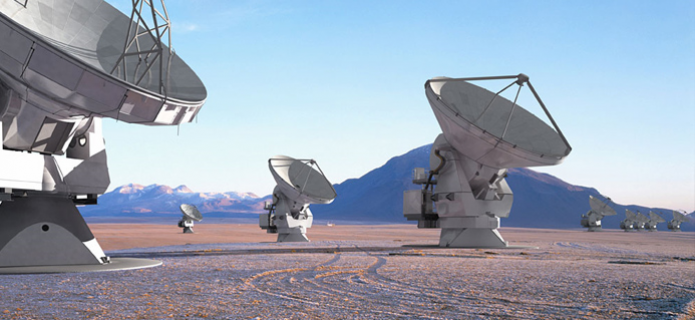ALMA partners award prototype antenna contracts in Europe and the USA
ALMA is a planned telescope array, expected to consist of 64 millimeter-wave antennas with 12-meter diameter dishes. The array will be built at a high-altitude, extremely dry mountain site in Chile's Atacama desert, and is scheduled to be completed sometime in this decade.
The European partners contracted with the consortium of European Industrial Engineering and Costamasnaga (Mestre, Italy), on February 21, 2000, for the production of one prototype ALMA antenna. On February 22, 2000, U.S. partners signed a contract with Vertex Antenna Systems (Santa Clara, California), for construction of another prototype antenna. The two antennas must meet identical specifications, but will inherently be of different designs. This will ensure that the best possible technologies are incorporated into the final production antennas.
Several technical challenges must be met for the antennas to perform to ALMA specifications. Each antenna must have extremely high surface accuracy (25 µm, or one-third the diameter of a human hair, over the entire 12-meter diameter). This means that, when completed, the surface accuracy of the ALMA dishes will be 20 times greater than that of the Very Large Array (VLA) antennas near Socorro (New Mexico, USA), and about 50 times greater than dish antennas for communications or radar. The ALMA antennas must also have extremely high pointing accuracy (0.6 arcseconds).
An additional challenge is that the antennas, when installed at the ALMA site in Chile, will be exposed to the ravages of weather at 5000 m elevation. All previous millimeter-wavelength antennas that meet such exacting specifications for surface accuracy and pointing accuracy have been housed within telescope enclosures.
The U.S. and European prototype antennas will be delivered to the NRAO VLA site in October and November of 2001, respectively. Preparations for ALMA prototype testing are already underway at the VLA site. Three pads are being constructed for the antennas to rest on. An ALMA control room within the VLA control building is being established. About ten full-time ALMA staff will be involved in the testing. Additionally, ALMA project members from around the U.S. and the world will visit the VLA site to participate in the test program. The two prototype antennas will first be tested separately. Following that, the two will be linked together and tested as an interferometer.
Millimeter-wave astronomy is the study of the universe in the spectral region between what is traditionally considered radio waves and infrared radiation. In this realm, ALMA will study the structure of the early universe and the evolution of galaxies; gather crucial data on the formation of stars, protoplanetary disks, and planets; and provide new insights on the familiar objects of our own solar system.
